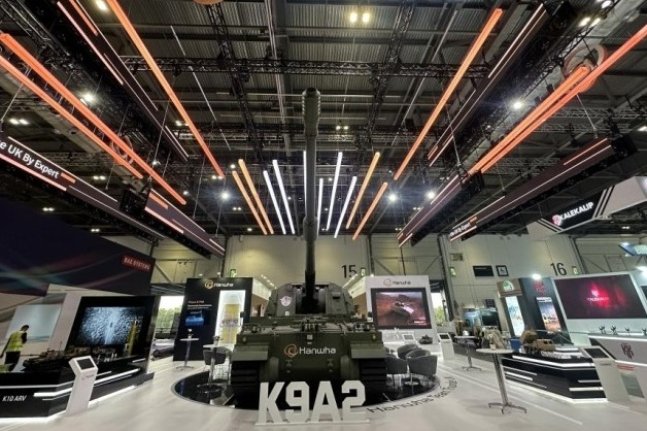
London: South Korean defence company Hanwha Aerospace will showcase its extensive array of defence technologies at the upcoming DSEI 2023 event, scheduled to take place from September 12-15 at ExCel, London.
The K9A2 Self-Propelled Howitzer (SPH) platform, which will feature the innovative Composite Rubber Track (CRT) developed by Soucy Defence will be one of the highlights of their presentation. This development marks a significant step forward in creating a British variant of the K9A2 that aligns with the requirements of the UK Mobile Fires Platform (MFP) program. Building upon the success of the K9A1, which has already seen over 1,800 platforms in service and holds a commanding presence in the global SPH market, the K9A2 is designed to enhance both lethality and survivability. Key improvements include a fully automated turret and the incorporation of composite rubber tracks.
Simon Humphrey CBE, Vice President of Hanwha Aerospace UK, emphasised the game-changing nature of CRT technology. It not only facilitates all-weather terrain accessibility for shoot-and-scoot operations but also contributes to reduced noise, vibration, maintenance, and fuel consumption, ultimately enhancing operational mobility.
Spearheading Team Thunder UK, a unique international partnership that brings together accomplished UK defence manufacturers, Hanwha Aerospace aims to deliver a cutting-edge mobile fires capability to the British Army in response to the MFP requirement. Notable members of Team Thunder UK include Lockheed Martin UK, Leonardo UK, Pearson Engineering, Horstman Defence Group, and Soucy Defence. Additionally, Hanwha Defence Australia has joined forces with Team Thunder to maximise synergies with the AS9 Huntsman program and the recent success of the Redback Infantry Fighting Vehicle. Leveraging similarities between the defence strategies of Australia and the UK, Hanwha seeks to apply the progress made in LAND 8116 to the MFP program.
Looking ahead, Hanwha Aerospace intends to expand Team Thunder by welcoming more UK SMEs and technology companies into the fold. This expansion aims to generate economic benefits for the UK, with a commitment to ensuring that at least 50 percent of the British K9A2 version’s manufacturing takes place within the UK.
Sun Wi, Director of Hanwha Aerospace’s Global Operations Office, underlined Team Thunder’s dedication to building a highly skilled industrial base. This endeavour will create numerous specialised jobs in the supply chain and establish local training programs for graduates and apprentices. Furthermore, the purchase of the K9A2 is expected to open doors for Team Thunder in the UK export market. Countries like Finland, Norway, and Estonia, which already use the K9, will need to upgrade to the A2 standard and present significant opportunities for export and cost-sharing among user nations.
Hanwha Aerospace, as part of its commitment to the UK Ministry of Defence (MOD) and collaboration with UK industry, has established Hanwha Aerospace UK. This establishment is now complete, and the presence of top leadership from Hanwha Aerospace across South Korea, Europe, the US, and Australia at DSEI 2023 underscores Hanwha’s strong desire to build new partnerships, foster existing relationships, and deliver high-quality technology and capabilities during a period of high global demand.
Expressing his commitment to forging a strong partnership with the UK through a program of investment and involvement with UK MOD and industry partners, Jaeil Son, President and CEO of Hanwha Aerospace highlighted South Korea’s strong national-level partnership with the UK and stressed Hanwha Aerospace’s determination to broaden collaborations with UK MOD and industry partners through investment and involvement in the UK defence ecosystem. This program encompasses collaborative R&D, support for academia, and contributions to the growth of key skills, particularly in STEM (Science, Technology, Engineering, and Mathematics) subjects.
Hanwha Aerospace’s commitment to investment and involvement within the UK Defence Sector, in conjunction with the anticipated success of the Team Thunder UK initiative, is poised to enhance industrial cooperation between Hanwha Group and UK partners across various sectors, including aerospace, shipbuilding, communications, and energy solutions. Hanwha Group operates a diverse array of subsidiaries within these markets.
Hanwha operates across a wide spectrum of business areas, including aerospace, defence, energy, materials, finance, retail, and services and is ranked as the seventh largest company in South Korea and a Fortune 500 company.
At DSEI 2023, Hanwha Aerospace will present a diverse range of defence capabilities which includes:
K9A2: The K9A2 represents the latest evolution in the K9 family. Notably, it boasts a fully automatic ammunition handling system, significantly increasing its fire rate to at least 9 rounds per minute. This advancement reduces the crew requirement from five to three and enhances tactical mobility with the inclusion of the Composite Rubber Track.
K239 Chunmoo: The K239 Chunmoo Multiple Rocket Launcher System (MLRS) is a cutting-edge rocket artillery system capable of engaging enemy targets in real-time while minimizing collateral damage to friendly forces. It can engage targets at ranges of up to 80 km or 300 km.
TAiper: TAiper is an anti-tank guided missile (ATGM) with an impressive range of 8 km. Its versatility allows integration onto various platforms, including main battle tanks, armoured combat vehicles, and unmanned ground vehicles.
Redback: The Redback Infantry Fighting Vehicle (IFV) represents the next generation of IFVs, offering superior battlefield mobility and armoured protection. With features like a 1,000 HP powertrain system, in-arm hydro-pneumatic suspension unit, and Composite Rubber Track, the Redback excels in maneuverability and survivability.
Lithium-ion Battery for Submarine: Hanwha Aerospace is responsible for integrating world-class lithium-ion batteries into the ROK Navy’s 3,000-ton submarines. These batteries double the underwater operational hours compared to lead-acid batteries, enhancing the capabilities of these submarines significantly.








